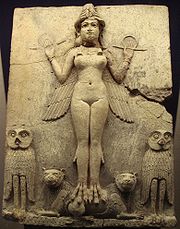
Rod-and-ring symbol
Encyclopedia

Cylinder seal
A cylinder seal is a cylinder engraved with a 'picture story', used in ancient times to roll an impression onto a two-dimensional surface, generally wet clay. Cylinder seals were invented around 3500 BC in the Near East, at the contemporary site of Susa in south-western Iran and at the early site...
s and relief
Relief
Relief is a sculptural technique. The term relief is from the Latin verb levo, to raise. To create a sculpture in relief is thus to give the impression that the sculpted material has been raised above the background plane...
s. It is held by a god or goddess and in most cases is being offered to a king who is standing, often making a sacrifice, or otherwise showing respect. The symbol dates from the Sumerian Renaissance to the Neo-Assyrian Period, and is commonly explained as a coil of measuring string and a yardstick. Other theories are that they are a shepherds crook and a noserope, or that the ring is no rope at all.
The best known example of the symbol is seen on the Code of Hammurabi
Code of Hammurabi
The Code of Hammurabi is a well-preserved Babylonian law code, dating to ca. 1780 BC . It is one of the oldest deciphered writings of significant length in the world. The sixth Babylonian king, Hammurabi, enacted the code, and partial copies exist on a human-sized stone stele and various clay...
stela. The most elaborate depiction is found on the Ur-Nammu
Ur-Nammu
Ur-Nammu founded the Sumerian 3rd dynasty of Ur, in southern Mesopotamia, following several centuries of Akkadian and Gutian rule...
-stela, where the winding of the cords has been detailed by the sculptor. This has also been described as a "staff and a chaplet of beads". There is discussion whether the Ur-Nammu-stela is showing the same thing.
Scepter, throne, and ring: Enuma ElishEnûma ElishThe is the Babylonian creation myth . It was recovered by Austen Henry Layard in 1849 in the ruined Library of Ashurbanipal at Nineveh , and published by George Smith in 1876.The Enûma Eliš has about a thousand lines and is recorded in Old Babylonian on seven clay tablets, each holding...
The myth of InannaInanna
Inanna, also spelled Inana is the Sumerian goddess of sexual love, fertility, and warfare....
's descent to the nether world describes how the goddess dresses and prepares herself: "She held the lapis-lazuli measuring rod and measuring line in her hand."
In tablet IV of the Enuma Elish
Enûma Elish
The is the Babylonian creation myth . It was recovered by Austen Henry Layard in 1849 in the ruined Library of Ashurbanipal at Nineveh , and published by George Smith in 1876.The Enûma Eliš has about a thousand lines and is recorded in Old Babylonian on seven clay tablets, each holding...
, the rod and ring symbol is referenced as:
- "They rejoiced, and they did homage unto him, saying, "MardukMardukMarduk was the Babylonian name of a late-generation god from ancient Mesopotamia and patron deity of the city of Babylon, who, when Babylon became the political center of the Euphrates valley in the time of Hammurabi , started to...
is King!"
They bestowed upon him the scepter, and the throne, and the ring.
They gave him an invincible weaponry which overwelmeth the foe."
Symbols that appear similar
- The Egyptian Shen ringShen ringA shen ring is a circle with a line at a tangent to it, which was represented in hieroglyphs as a stylised loop of a rope. The word shen itself means, in ancient Egyptian, encircle, while the shen ring represented eternal protection...
has an identical resemblance. - The Greek goddess Nike uses a different type of investitureInvestitureInvestiture, from the Latin is a rather general term for the formal installation of an incumbent...
symbol for the victor in the sporting races, a wreath of laurel, or a wreath of olive branches, but she is depicted with a ring, a rigid circle. - The FaravaharFaravaharFaravahar is one of the best-known symbols of Zoroastrianism, the state religion of ancient Iran. This religious-cultural symbol was adapted by the Pahlavi dynasty to represent the Iranian nation....
, the symbol of ZoroastrianismZoroastrianismZoroastrianism is a religion and philosophy based on the teachings of prophet Zoroaster and was formerly among the world's largest religions. It was probably founded some time before the 6th century BCE in Greater Iran.In Zoroastrianism, the Creator Ahura Mazda is all good, and no evil...
, also holds a ring. - The Egyptian AnkhAnkhThe ankh , also known as key of life, the key of the Nile or crux ansata, was the ancient Egyptian hieroglyphic character that read "eternal life", a triliteral sign for the consonants ʻ-n-ḫ...
has a vaguely similar form but is used in very different contexts. - At the 6th century B.C.E. archaeological site of Cancho RoanoCancho RoanoCancho Roano is an archaeological site located in the municipality of Zalamea de la Serena, in the province of Badajoz, Spain. Is located three miles from Zalamea de la Serena in the direction of Quintana de la Serena Quintana, in a small valley along the stream Cagancha.Cancho Roano is the best...
, located near Zalamea de la SerenaZalamea de la SerenaZalamea de la Serena is a municipality in the province of Badajoz, Extremadura, Spain. It has a population of 4,431 and an area of 245.7 km².Zalamea is famous for a play called “El Alcalde de Zalamea,” or the “Mayor of Zalamea.”...
, Badajoz, Spain, a large feature in the shape of the rod and ring symbol was modeled into the floor of the innermost chamber of a TartessianTartessianTertessian may refer to:*an ancient civilization based in Tartessos in modern-day Andalusia*the Tartessian language*the Tartessian script...
temple.
External links
- Inana's descent to the nether world at Electronic Text Corpus of Sumerian Literature
- The Enûma Elish

